November, 2005
Recent publication of the David Goewey book Crash Out about the deadly 1941 escape by three Sing Sing inmates, aided by at least two outside accomplices, prompted Bill Reel, columnist for the Brooklyn Catholic Diocesan weekly newspaper The Tablet, to write a piece about one of those accomplices: Edward Kiernan.
_
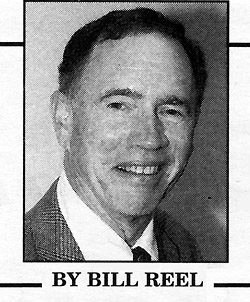 |
| Image of columnist Bill Reel photo and byline from The Tablet.
|
|
It tells how Reel came to know Eddie Kiernan late in the ex-con's life after release from prison to which he had been sentenced for aiding the escape. It tells how, with the help of a Greenpoint priest, Eddie finally succeeded in gaining long- sought reconciliation with his family.With permission of The Tablet and Bill Reel, his Nov. 5, 2005 column -- entitled A Classic Story of Forgiveness -- is reproduced in this web presentation by NYCHS.
Click the Bill Reel image (right) to access his column text.
Originally Kiernan and his fellow accomplice, William Wade, had been sentenced to life imprisonment for their part in the 1941 escape.
Like the escapees Joseph "Whitey" Riordan and Charles McGale, who were tried with them, the accomplices had been convicted in the murder of prison guard John Hartye. He had been shot with one of the guns that Wade and Kiernan were charged with smuggling into the prison.
But unlike the escapees, the accomplices were spared death sentences because the jury recommend mercy for them.
_
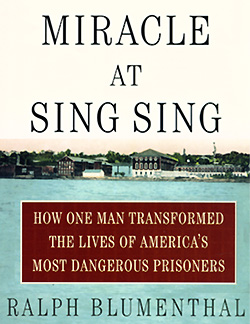 |
Image of the cover of Ralph Blumenthal's
Miracle at Sing Sing.
|
|
Chapter 35 and the first two pages of Chapter 36 of Ralph Blumenthal's excellent biography of Warden Lewis E. Lawes, Miracle at Sing Sing, provide a very readable account of the escape and its aftermath.With author Ralph Blumenthal's permission, relevant excerpts from Ch. 35 and 36 are reproduced in this NYCHS web presentation to provide background information.
Click the Miracle at Sing Sing book cover image (left) to access its excerpts.
Kiernan's release from prison came three years after a federal court panel found that the unsigned confession used in evidence against Wade had been coerced. With excruciating detail, the 1958 opinion written by Joseph Edward Lumbard, sitting on the U.S. Court of Appeals Second Circuit panel, laid out the factual and legal basis for setting aside Wade's conviction.
_
 |
Seal of the 2nd Circuit,
U.S. Court of Appeals.
|
|
Cited were the specific physical injuries sustained during and after his arrest and prior to his so-called confession.
Former U.S. Attorney for the Southern District, Justice Lumbard served as the 2nd Circuit's chief judge from 1959 until his death June 3, 1999.
Home base for the 2nd Circuit is Thurgood Marshall U.S. Courthouse at 40 Foley Square in Lower Manhattan.
Click the 2nd Circuit's logo (above right) to access excerpts from Judge Lumbard's opinion in the Wade case, including an extensive recounting of the escape, arrests, interrogation and trial.
In language remarkably blunt for a judicial document, Judge Lumbard wrote:
Taking a man to the state police barracks, keeping him incommunicado for 23 hours during which he is permitted no sleep,
| The Relevance of Remembering
What is the relevance of revisiting in 2005 the deadly 1941 Sing Sing escape?
Remembering Correction involves hope of remorse, reform, and reconciliation is always relevant.
Remembering the service and sacrifice of officers killed in the line of duty is always relevant.
Remembering authorities' duty to stay within limits the law imposes on power conferred is always relevant.
---- ---- ---- ------ ------ ----- ----- ---- ---- --- NYCHS webmaster.
|
|
with no food whatsoever, and only two glasses of liquid after many hours, submitting him to constant questioning despite his denials, is not only degrading and uncivilized but it is obviously coercive.
This treatment, without convincing explanation of its reasonableness, is sufficient to indicate that the resulting statement was involuntary and that it was given to put an end to what most of us would consider torture. . .
The uncontradicted reports and testimony of three doctors tend to show that Wade bore marks on his body which were consistent with his claim that he was beaten during his 23 hour restraint.
_
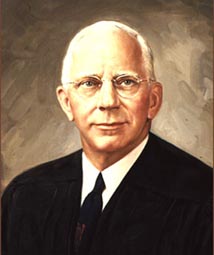 |
| Judge Charles Froessel.
|
|
Kiernan's attempt to have his own conviction set aside, based on the federal finding in the case of his co-accomplice Wade, was rejected by New York's highest court in an unanimous ruling.
Also a former prosecutor, Judge Charles Froessel wrote the State Court of Appeals opinion.
It noted that, unlike Wade, Kiernan had not taken the stand at trial to testify to violence and depredations inflicted during the many, many hours of interrogation.
Click Judge Froessel's image (above right) to access excerpts from the State Court of Appeals opinion rejecting Kiernan's bid to undo the conviction.
After the state turndown, Kiernan took his case to the federal court in Albany.
There, Federal District Court Judge James T. Foley found himself having to write a decision for Kiernan contrary to what he had ruled against Wade.
_
 |
| James T. Foley Federal Courthouse in Albany.
|
|
His ruling against Wade had been reversed by the higher federal appellate panel led by Judge Lumbard.
Much of Judge Foley's opinion reads like a treatise on the convolutions of the appellate process.
Click the image (left) of the James T. Foley Courthouse in Albany for his opinion excerpts specifically related to the Kiernan case.
Through the decades since the deadly 1941 Sing Sing escape, various commemorations have been held to honor its fallen victims -- prison guard John Hartye and village police officer William Fagan.
_
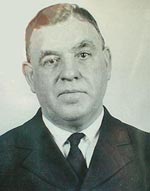 |
| The above image of guard John Hartye, killed in the 1941 escape, appears -- courtesy of Ossining Historical Society -- in Mark Gado's Stone Upon Stone: Sing Sing Prison on Court TV's Crime Library web site. Click image to access NYCHS excerpts from it.
|
|
The book, Crash Out: The True Tale of a Hell's Kitchen Kid & the Bloodiest Escape in Sing Sing History, whose publication announcement prompted Tablet columnist Reel to write his A Classic Story of Forgiveness column about Eddie Kiernan, begins with author David Goewey recounting attendance at the prison's April 14, 2003, memorial rites:
"[This] morning the convicts are not mentioned by name; their ignominy is obvious to everyone present. But for me, the fugitives are there too, haunting the event, shadows behind the somber reverence. . . "
The 305-page book moves the fugitive convicts and their accomplices out of the shadows of the past.
_
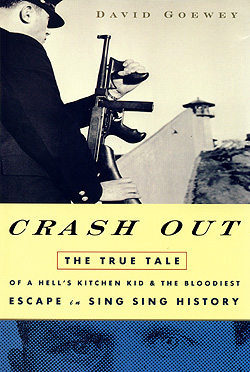 |
| Cover of David Goewey's Crash Out: The True Tale of a Hell's Kitchen Kid & the Bloodiest Escape in Sing Sing History.
|
|
Goewey writes as one familiar with Correction perspectives and nuances. Born and raised in Ossining, David is the grandson, son and brother of Sing Sing prison officers and formerly taught in the Rikers Island inmate education program.
Although the book itself covers in depth the entire story of the escape by inmates Waters, Riordan, and McGale, the excerpts from it that form Page 7 of this NYCHS presentation highlight the reputed role of Kiernan as the chief outside accomplice who smuggled into Sing Sing the guns with which the escapees killed prison guard Hartye and Ossining patrolman Fagan. To access the Crash Out excerpts, click the book cover image right.
The scene with which Goewey opens his book was the 62nd annual memorial event at Sing Sing honoring Hartye and Fagan.
About three years earlier in Albany, as bagpipes played, bugles echoed and rifle fire resounded, the NY State Department of Correctional Services dedicated at its Training Academy a permanent memorial to all civilian and uniformed employees who died as the result of inmate actions. The wording on the Empire blue granite monument in front of the academy reads:
Inside the academy building, the walls of a Memorial Room feature plaques citing the honorees individually. One reads:

